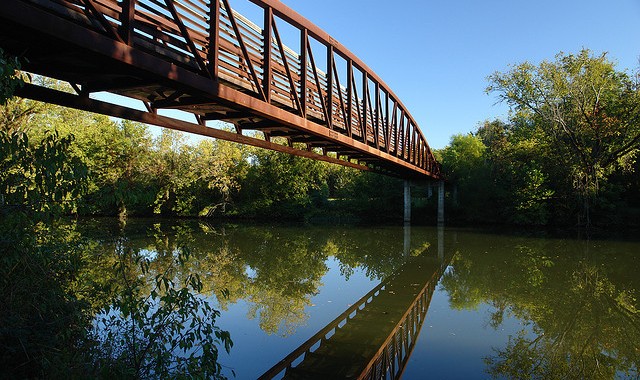During the 15th annual SENCER Summer Institute, SENCER Co-PI and SCI-MidAtlantic co-director Monica Devanas and her assistant Yuxi Chen captured film footage of various talks and presentations. This series highlights the collection, packaged as webinars, to spark ideas and inspiration, share knowledge and strategies, and celebrate the wide-ranging and deep-reaching work performed by our SENCER community.
In this webinar, Visiting Assistant Professor of Biology at Middle Tennessee State University (MTSU) R. Drew Sieg describes how his EXL (Experiential Learning) Honors Ecology course provides students the opportunity to gain real research experience. The EXL program at MTSU is dedicated to giving students experience with co-operative education, leadership development, and service learning.
Drew partnered with nearby Murfreesboro Greenway System, a 12-mile long ecological site that follows along Stones River. The area has wetlands, trailheads, and stream and forest ecology. Murfreesboro Greenway System representatives were thrilled to partner with Drew and his students, since they did not have many partners doing college-level research on the system.
As part of the partnership, Drew’s students were assigned to complete a semester-long research project of their own design about the health of the Greenway ecosystem. Many of Drew’s students had never visited the Greenway System before, so Drew took the class to the site to find a topic they could research. They parked by the Bark Park, an area where people could bring their dogs to run and play. One of the rules of the Bark Park, as designated on a sign, is that all owners should dispose of their pets’ waste in trash receptacles. The students noticed, however, that not all dog owners complied with the rules. The students wondered if runoff from the dogs’ waste could be having negative environmental impacts on the West Fork of Stones River, which is directly downhill from the Bark Park.
All seven students in Drew’s class collaborated on the project together. The project had two main areas of focus:
- Does fecal input from the Bark Park increase fecal indicating bacteria?
- Can water quality of West Fork Stones River be assessed using benthic macroinvertebrates?
The students were responsible for coming up with the experimental methods. Drew urged them to do literature searches of published research to find techniques that would apply to their situation. For the first area of focus, Drew’s students found a technique that Drew had never used himself, but that turned out to work very well, highlighting a benefit of extending greater autonomy and responsibility to students.
In addition to designing their own experiments, the students also had to submit a research proposal for Drew’s review, as if he were a funder. The students needed to include a budget (under $300), and describe the intellectual and community impact of their project, something they would need to do as graduate students and full-time scientists.
While all of the students were able to work on all aspects of the project, they did divide themselves up into subcommittees of “experts” according to their strengths to better manage the tasks. At first, Drew said, some of his students were slightly intimidated by choosing their own project and designing their own experimental methods, but ultimately this sense of ownership led the students to go the extra mile. One day, they chose to go to the Greenway System before their lab period started to collect samples, so that they would have the full lab time to analyze what they found, and they performed a more advanced statistical analysis of their data than what Drew had required.
The students presented their findings at a community forum organized by Drew. He invited other faculty and community members, including representatives from Parks and Recreation. The students didn’t find a large difference in water quality between areas upstream and downstream of the Bark Park, but they did find that the West Fork overall was relatively polluted. The Parks and Recreation representatives were able to give students further insight on their results, by mentioning a nearby carwash that could be contributing to pollution through runoff, and other examples. The students also made a pamphlet for the Bark Park describing their research findings, and ways to protect the area, to help educate and inspire elementary and middle school visitors.
Drew recommends that other teachers who want to try a similar approach should look around their local community for potential partners, who are likely to be more than willing to collaborate, and to not be afraid of letting students take the lead in picking their own research topics and designing their own experiments.
To learn more about Drew’s EXL Honors Ecology course and its outcomes, view his webinar.
Photo credit: patchattack (CC BY-SA 2.0)

